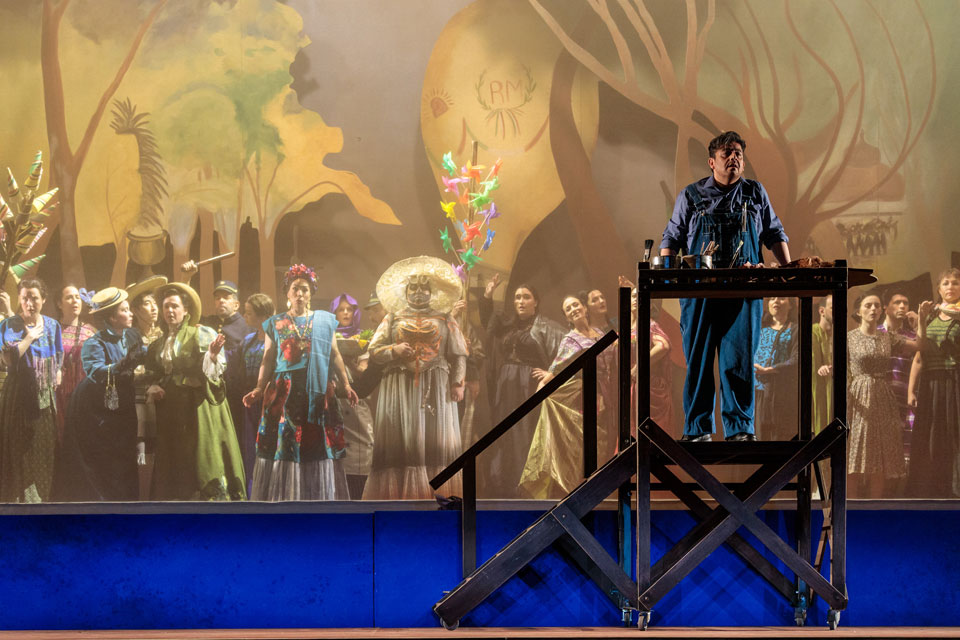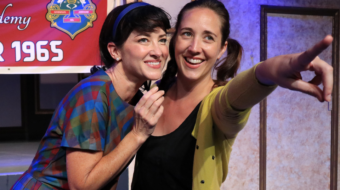
SAN DIEGO (Oct. 29) — The opera season here kicked off tonight with the world premiere of El último sueño de Frida y Diego (The Last Dream of Frida and Diego) by Grammy Award-winning composer Gabriela Lena Frank in her first foray into opera, and Pulitzer Prize-winning librettist Nilo Cruz. Fifteen years in the making, the new opera is a stunner, gorgeously produced, lovingly performed.
Frida Kahlo and Diego Rivera have inspired generations of artists around the world, and the opera explores the relationship between these two iconic Mexican visionaries. Rivera is known for his expansive large-scale murals packed with people and history, while Kahlo became famous for her intimate, personal, introspective meditations on pain, popular culture and the meaning of life itself. Both were passionate revolutionaries who often got into trouble not only with government authorities but with commissioning sponsors. The story of Diego Rivera’s mural at New York’s Rockefeller Center being demolished because he refused to eliminate an image of Lenin has come to symbolize the plight of art under capitalism. His great mural celebrating labor at the Detroit Institute of Arts still attracts admirers from around the world. Both Rivera and Kahlo were at various times members of the Communist Party of Mexico. A recent Mexican 500-peso bill featured each of their images on reverse sides—not bad coming from a capitalist country!
The opera refers several times to their love for Mexico’s poor and exploited, but more specific political identities have been downplayed—art under capitalism? There is also a poetic apostrophe to Tenochtitlán, the bustling metropolis that was the capital of the Aztec empire, where Mexico City stands today, and the wealth of a continent pirated away to Europe in chests and ships.

During the celebration of Día de los Muertos (Day of the Dead), surrounded by candles and the fragrance of marigolds, the celebrated artist longs to see his deceased wife Frida once more. Catrina, the keeper of souls and the go-between controlling their passage between the underworld and the aboveground, approaches Frida in her peaceful afterlife, and explains that Diego desperately needs his beloved wife as the end of his life approaches. For only 24 hours, which will be Rivera’s last day on earth, they will relive their tumultuous love through their paintings and embrace the mutual devotion they shared. He is able to bring her back to her beloved Casa Azul, her “Blue House,” where she painted many of her most memorable canvases. And then she is able to accompany him when it is his turn to pass and she must go back.
El último sueño… is San Diego’s fourth world premiere, fitting in well with the demographics and geographics of the city, located just a few miles north of the border. It features an international cast in a production directed by Lorena Maza and conducted by Roberto Kalb, and sung in Spanish. A new supertitle system gives the audience the complete text in simultaneous English and Spanish. The approximate run time is 2 hours, including one intermission. The opera is a co-commission with San Francisco Opera, Fort Worth Opera, DePauw University School of Music, and also has support from The University of Texas at Austin College of Fine Arts. Five performances of the opera are scheduled for June 2023 in San Francisco.
Composer Gabriela Lena Frank is one of the best-known concert composers in America today. She grew up in the Bay Area and is, like Kahlo, a mix of European and Latin American (Peruvian) cultures. One of her earliest fascinations was with Kahlo’s art, which she recalls as being the only work by a woman artist included in her mother’s multi-volume set of “great artists.” Her task, as she sees it in this opera, “has been to create colorful and characterful music befitting multiple planes of existence—the world of the living, the world of the dead, and briefly, an especially poignant world of Art.”

The librettist, Nilo Cruz, a Cuban American, is Frank’s longtime collaborator and a distinguished dramatist in his own right. Among his many theatrical works, he is most famous for his Pulitzer Prize-winning play Anna in the Tropics, which takes place in a Tampa cigar factory. He exercises nuanced control over this rich biographical and cultural material, perhaps summed up in Frida’s recall of the two great accidents that defined her life: her youthful encounter with a tramway that left her in lifelong agony, and meeting Diego Rivera. Diego muses on going on with his work after her death, singing, “How can I paint your absence?” After the two are reunited, Diego tells her she will live on in canvases “where time is detained.” In a scene where beggars are pestering them for coins, Cruz has Diego observe, “The poor are invisible,” to which Frida answers, “Like the dead.” Both composer and librettist were on hand to take their well-deserved bows at the curtain calls on opening night.
Mexican director Lorena Maza expresses her honor being invited to participate in this project. Her challenge was to make her characters come to life in a way that would not come across as clichéd and saccharine. “This is a perfect story for an opera,” she writes in a program note. “It’s about love, pain, art, death, passion, politics, sex, gender, diversity, and disability. It’s multilayered and multidimensional, as its characters, but in the end, it is a love story. It talks about love beyond life, a journey from the underworld and back; it’s about passion for art and finding identity through art, about forgiveness, and surrender. The story is also a dream…the context is enormous and couldn’t be more dramatic.”
El último sueño… positions itself in a long history of opera about artists of different kinds. Going back to the earliest days of the form, Claudio Monteverdi (1567-1643) tackled the subject of the poet Orpheus in L’Orfeo (1607), the mythical character who loses his bride Eurydice, also travels to the underworld to try and retrieve her, and devotes the rest of his life to turning his grief into art. From the beginning, composers have attempted to capture in music the essence of another art form. Hector Berlioz’s 1838 opera Benvenuto Cellini treats the life of a sculptor, while Giacomo Puccini wrote about poets, painters and actors in La Bohème and Tosca. In 2019, the American composer Kevin Puts wrote The Brightness of Light, a staged song cycle about photographer Alfred Stieglitz and his marriage to painter Georgia O’Keeffe. And in the opera M. Butterfly, premiered this past summer at Santa Fe, the original playwright David Henry Hwang adapted his play about a singer for the Peking Opera into a libretto set to Huang Rao’s music.

Many readers will find the name Catrina familiar. She is the elegantly decked-out lady calavera (skeleton) with the broad-brimmed hat that 19th-century Mexican artist José Guadalupe Posada created as part of his cast of characters satirizing Mexican life. She has become a popular figure in Mexican folklore. Rivera painted a 15-meters mural in the years 1946-47, now housed in the Museo Mural Diego Rivera adjacent to the Alameda in the historic Mexico City center. In this detail a viewer can see Frida Kahlo to the left of Catrina, who is draped with a feathered serpent, one of the country’s most common symbols, and Rivera’s self-portrait as a young dandy in front of Frida and holding hands with Catrina. Another historical figure is Cuban revolutionary José Martí, standing left of Frida.
In the opera the role is sung by Mexican soprano Maria Katzarava, who has performed leading roles in opera houses around the world. As a kind of Queen of the Night (think Mozart’s The Magic Flute) but now the interface between Miclantecuhtli, the god of death, and the world of the living, she skillfully negotiates Frank’s often coloraturistic writing. She is imperious and caring at the same time, teasingly handing out tickets to visit earth. When she appears in the cemetery where Diego on the Day of the Dead is visiting Frida’s grave, she offers to sell him “flores para los muertos” (flowers for the dead), he protests that he’s not dead. “But I sense that you soon will be,” she predicts mordantly.
The important semi-comical role of Leonardo is taken by countertenor Key’mon Murrah, who occasionally slips into his baritone range for humorous effect. Leonardo was an actor in life, and he wants to answer the dream of a lonely man on earth who every year hopes to see his heroine Greta Garbo as Queen Christina come back to say hello. Leonardo dresses and acts the part, and of course succeeds. There’s a touch of Kiss of the Spider Woman in this role. It’s he who influences Frida to go back this Day of the Dead to visit Diego. His plea for pity to be allowed to go back once more is a rather funny evocation of the famous soprano aria from Puccini’s Gianni Schicchi, “O mio bambino caro.”
The two leads are mezzo soprano Guadalupe Paz as Frida and Mexican baritone Alfredo Daza as Diego. Paz is the only one of the opera’s four principal singers who has previously appeared with the company—as Mercedes in Carmen. She is sought after internationally not only for her Rossini roles but for modern works as well. Daza has a globe-spanning career with a large repertoire of mostly standard roles in Verdi, Puccini, and Rossini. They are well cast as lower voices for their genders. A soprano and tenor in these roles might have been aurally disruptive, the audience constantly on the edges of their seats waiting for some vocal pyrotechnics and high C’s. At the end, when the two sing their final farewell to the world one can only think of the last scene of Verdi’s Aïda, when the heroine and her lover Radamès, united forever in the tomb, harmonize on “O terra addio.” In this opera, the bright blues of the Casa Azul are gradually taken over by the earthen ochres of the soil, as minor chords (à la Mimi’s death in La Bohème) signal the moment of Diego’s transition.
San Diego Opera could not have done better casting these roles. A world premiere draws attention to the company and to the performers. Especially if a new opera takes off and establishes itself in the modern repertoire, it is always a career touchstone to have created the original roles under the eye of the living composer. History records the first Carmen, the first Wotan, Butterfly, Salome.
This is a new production, built at the San Diego Opera Scenic Studio and San Diego Opera Costume Shop. The set designer is Jorge Ballina, the costume designer is Eloise Kazan, and the lighting designer is Victor Zapatero. The stage set operates on several levels and I sense that ample use of the theater’s technological potential has been put into play: At one point we see both the worlds of the living (above) and of the dead (below).
For a first operatic score Gabriela Lena Frank has hit the jackpot. Time will tell if the operatic idiom will now loom larger in her future output, but if she has been considered an admired and gifted composer before now, her star has definitely risen a few degrees in the world. Opera has a way of doing that!
Only two more performances of the opera remain. Tickets can be obtained here. The San Diego Civic Theatre is located at 1100 Third Avenue, San Diego 92101.










